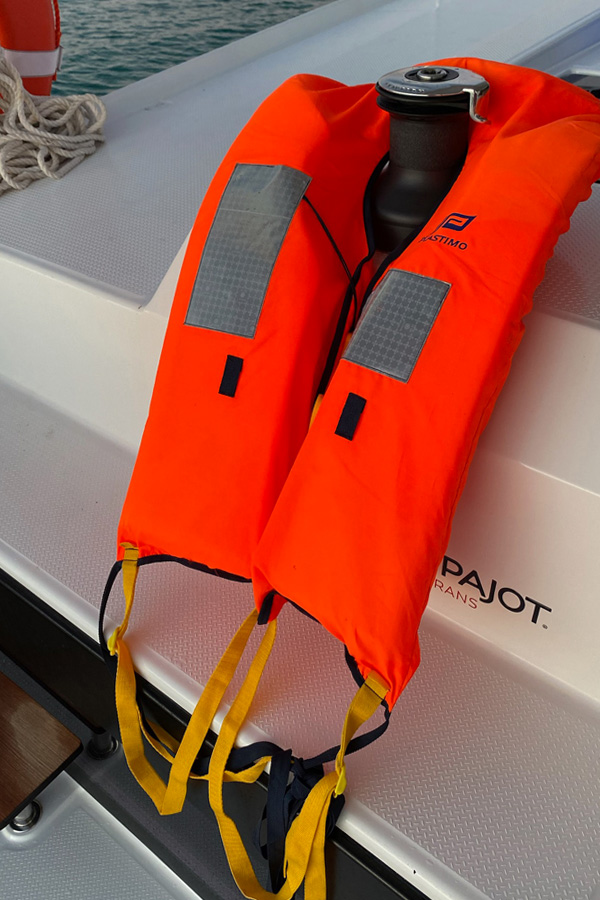August 3, 2022 - Comments Off on Permission to come aboard?
Permission to come aboard?
Shipshape leadership depends on both captain and crew

This article continues from Reading The Waves.
My first few nights living aboard a catamaran learning to sail were eye opening. We were both relaxed, bobbing on crystal-clear turquoise waters, and alert to the area’s features– shorelines, rock outcroppings and coral reefs, as well as the sea conditions shaped by current, surf and wind direction. Once anchored in a lovely inlet in the Sea of Cortez, we could enjoy a splash in the water or walk on the beach. The sunsets were sensational, casting a hundred hues on the water’s surface from the sky and shore. Icy blue, peach blush, deep lapis, and silver all moved together in undulating patterns.

Less is Moor
From the outset, our captain, Troy Mills, assigned each crew member one night as host (cook) and a day as captain (skipper). Most of the time, I was taking initiative while following directives. It’s an interesting combination that resonates within working environments and other relationships, but not always second nature. I liked working the sheets to trim the sails, making slight adjustments under the captain’s direction to optimize the wind. I relished setting the mainsheet, winching, unfurling the jib, flaking and stowing the sheets—becoming a master of my post. When the captain called out “Ready about?” the crew answered, knowing their tasks and adjusting as needed. I enjoyed tying knots, calculating knots and anchor chain length, assessing wind direction and apparent wind speed, and assisting the captain with making the boat secure at anchorage. Captain Troy was both patient and assertive, using humor to bridge a safe learning environment with a pleasure cruise.
I fit well in every space—the tiny head complete with standup shower, the efficient berth with drawers and lockers secreted under the bed and overhead. Everything was designed with less is more in mind. Less weight. Less space. Less waste. The galley was compact and efficient, anything needed within arm’s length. Under the seat cushions in the benches and floors of the saloon were concealed compartments to stow a pantry of provisions. The chart table tucked into one side of the bench. The cockpit was the largest outdoor sheltered area, with the helm raised to one side for a view of all the sails through the windows and ceiling of the bimini.

Mooring practice was on day two, as we started to take the helm and learn to sail. We arrived early at a large rock, covered in barking sea lions ready to play with anyone who delighted in a murky water snorkel. We learned to drop the lines around the seaweed-laden buoy rope with teamwork—a person catching it with a hook and the other with a looped line. The helmsman made slow maneuvers guided by the bow crew’s hand signals. Once we each succeeded in driving and mooring the boat, we sailed to another island.
We settled in an inlet for our first test—all the terms and boat basics. It took an hour to fill in 100 dots to complete our ASA 101 and the entire crew was elated to have scored in the upper 90s. We swam in temperate waters with a school of puffer fish and explored the anchorage on paddleboards. Another long sunset capped off the day and a long sleep.


Accidental Jibe
As we all have experienced, best laid plans can still result in unforeseen events. In the creative world we call these moments happy accidents. On a sailboat, most accidents aren’t jovial. My turn as captain at the helm gave me experience with an accidental jibe, the riskiest move at sea, primarily because the swinging mast can surprise a crew member, knocking them off kilter or off the boat entirely. Thankfully, on a big boat in light winds, it’s a learning experience. I was working on my jibing, wind to aft, changing from a beam reach to a broad reach, and figuring out the steering. Choosing a course, setting a heading, and then zigzagging your way toward it are three distinctive thoughts. I was focused on going to my point of sail in a straight line. I quickly discovered; it doesn’t work that way. Amazingly aligned with how we move through our lives and careers.
“I was focused on going to my point of sail in a straight line.
I quickly discovered; it doesn’t work that way.”
After lunch in another pretty inlet, we motored out to catch the wind, and suddenly without warning, a bright orange personal flotation device (PFD) was overboard! One crew member yelled “Man overboard!” and pointed at the bobbing faux passenger, their role now established as watch—keeping their eye on it until it was rescued. The helmsman made a curvy maneuver to recover the “MOB” under power, being sure to not run it over. The other crew had a hook and line ready, giving hand signals and proximity updates (10 feet! 5 feet!) upon approach. Each crew had their turn to recover our drunken sailor under power and under sail, with each technique being slightly different. Noting the wind direction and head-to-wind inclination of the boat can help or hinder a quick recovery, so it’s important to use the conditions in that moment to your favor. And make sure your crew is on board with safe behavior.


Time is fleeting
You cannot be in a hurry at sea. Calculating sail time is affected by wind which can and often changes hourly. When you’re away from it all, you don’t have access to timely wind reports so always have a time buffer built into your plan. The “MOB” exercises took much more time than expected; being under pressure for a quick rescue, it was easy to overshoot and need to start over. The pace of sailing a large catamaran is slow which gives you lots of time to think, but not much time to react. Planning your moves instead of reacting to the moment is key to a smooth sail.
Another day, another test. In the end, we all passed and received four ASA certifications that allow us to charter a boat on our own. Naturally, learning the sea can take a lifetime, but having the basics down is a great start to a wonderful adventure. It reminds me a little of heading out into my design career with a BFA in hand and a wanderlust for learning. All the beauty of life, its twists and turns, were rushing toward me. But now, I’m in no rush. Getting saltier by the day. —Helen


Join my mailing list to receive monthly reads about adventures, design, marketing, and leadership, and how they all relate to and inform one another.
- Photos by captain and crew of the journey, Helen, Karl, Troy, Rachel and David.



